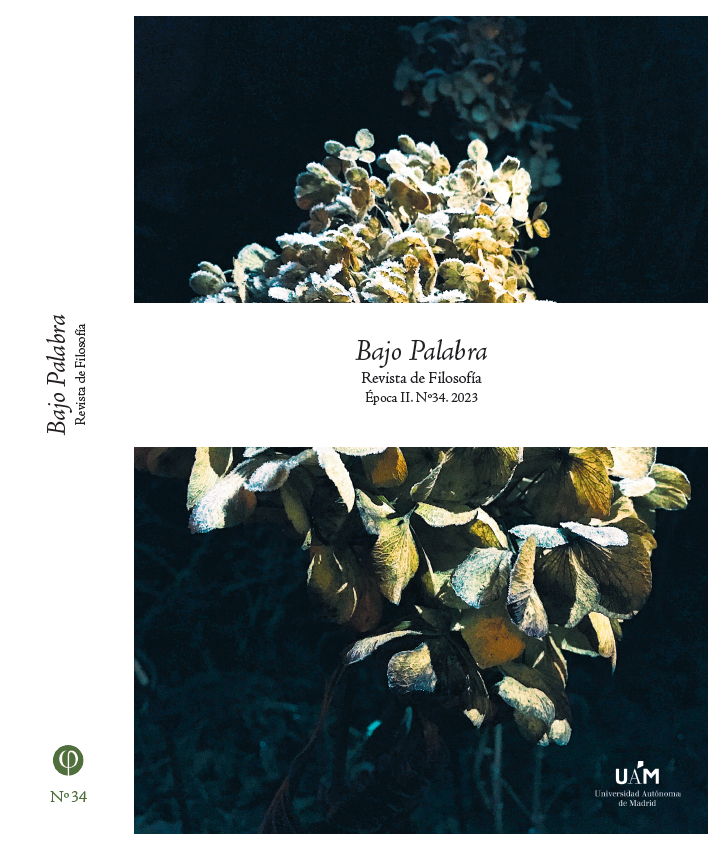Keywords:
Modern Epistemology, control, violence, gender, metaphor, earthCopyright (c) 2023 Henar Lanza González

This work is licensed under a Creative Commons Attribution 4.0 International License.
Abstract
In his Novum Organum, Bacon presents the inductive method through the metaphor of the penetration of Nature: the scientist must deflower the Earth. I will analyse the recourse to metaphor from the general theorisations of Aristotle, H. Blumenberg, A. Carson y S. Yurkasievich and the specific analysis of gender metaphors made by the feminist epistemology of S. Harding and E. F. Keller and by the ecofeminism and the philosophy of science of C. Merchant; I will outline the critiques against Baconian epistemology made from Critical Theory and M. Heidegger; I will propose a series of displacements that need to be made in scientific images and I will rescue some images from the philosophy of nature of Plato and Marcus Aurelius that can guide them and I will interweave them with poetry and the life sciences. The aim is to highlight a dual need to resurrect truths forgotten by modern scientific and philosophical rationality and to weave sciences and humanities to respond to the Anthropocene and to avoid the total fragmentation of knowledge.
Downloads
References
Arendt, H. (2003). La condición humana. Ramón Gil Novales (trad.). Barcelona: Paidós.
Aristóteles (1997). Poética. Valentín García Yebra (trad). Madrid: Gredos.
Aristóteles (2000). Retórica. Quintín Racionero (trad.). Madrid: Gredos.
Bacon, F. (1984). Novum organum. Cristóbal Litrán (trad). Madrid: Sarpe.
Badiou, A. (2010). Segundo manifiesto por la filosofía. Ma del Carmen Rodríguez (trad.). Buenos Aires: Bordes manantial.
Benjamin, W. (2005). Dirección única (Juan J. del Solar y Mercedes Allendesalazar, trad.). Barcelona: Alfaguara.
Blumenberg, H. (2003). Paradigma para una metaforología. Jorge Pérez de Tu- dela (trad.). Madrid: Trotta.
Boyd, R. (1993). “Metaphor and Theory Change: What Is ‘Metaphor’ a Metaphor for?”. En Andrew Ortony (ed.). Metaphor and Thought. Cambridge: Cambridge Univ. Press, pp. 481-532. https://doi.org/10.1017/CBO9781139173865.023
Carson, A. (2007). Hombres en sus horas libres. Ed. bilingüe. Jordi Doce (trad.). Valencia: Pre-Textos.
Carson, R. (2013). Primavera silenciosa. Joandomènec Ros (trad.). Barcelona: Crítica.
Chiang, T. (2019). The great silence. Recuperado de: https://nautil.us/issue/75/ story/the-great-silence
Coccia, E. (2021). Metamorfosis. Pablo Ires (trad.). Buenos Aires: Cactus. Commoner, B. (1971). The Closing Circle: Nature, Man, and Technology. New York: Knopf.
Crutzen, P. (2002). Geology of mankind. Nature 415, 23 https://doi-org. ezproxy.uninorte.edu.co/10.1038/415023a
Dartnell, L. (2019). Orígenes. Cómo la historia de a Tierra determina la historia de la humanidad. Joandomènec Ros i Aragonès (trad.). Barcelona: Debate.
Della Dora, V. (2021). The Mantle of the Earth: Genealogies of a Geographical Metaphor. Chicago and London: University of Chicago Press.
Durán, A. (2006). Un modelo científico para abordar la sostenibilidad. Jorge Riechmann, (coord.). Perdurar en un planeta habitable: ciencia, tecnología y soste- nibilidad, pp. 109-148. Barcelona: Icaria.
Emerson, R. W. (2010). Obra ensayística. Carlos Jiménez (trad.). Tenerife - Valencia: Artemisa.
Federici, S. (2010). Calibán y la bruja. Mujeres, cuerpo y acumulación originaria. Verónica Hendel y Leopoldo Sebastián Touza (trad.). Madrid: Traficantes de sueños.
Fricker, M. (2017). Injusticia epistémica. Ricardo García Pérez (trad.) Barcelona: Herder.
Hadot, P. (2015). El velo de Isis. Ensayo sobre la historia de la idea de Naturaleza. Maria Cucurella Miquel (trad.). Barcelona: Alpha Decay.
Haraway, D. J. (2016). Staying with the Trouble: Making Kin in the Chthulucene. Durham: Duke University. https://doi.org/10.2307/j.ctv11cw25q
Harding, S. (1986). The science question in feminism. Ithaca, NY: Cornell University Press.
Heaney, S. (1992) Norte (ed. bilingüe). Margarita Ardanaz (trad.). Madrid: Hiperión.
Heidegger, M. (1996). La época de la imagen del mundo. Helena Cortés y Arturo Leyte (trad.). En Caminos de bosque. Madrid: Alianza. Recuperado de: http:// www.fadu.edu.uy/estetica-diseno-i/files/2015/08/heidegger_epoca_imagen_ mundo.pdf
Horkheimer, M. (2002). Crítica de la razón instrumental. Jacobo Muñoz (trad.). Madrid: Trotta.
Horkheimer, M. y Adorno, Th. (1997). Dialéctica de la Ilustración. J. Sánchez (trad.). Madrid: Trotta.
Ingold, T. (2020). Antropología. ¿Por qué importa? Esther Gómez Parro (trad.). Madrid: Alianza.
Jaeger, W. (1981). Paideia. Los ideales de la cultura griega. (J. Xirau y W. Roces.) Madrid: FCE.
Keller, E. F. (1991). Reflexiones sobre género y ciencia. Ana Sánchez (trad.). Valencia: Alfons el Magnànim.
Keller, E., & Mansour, M. (1992). De los secretos de vida a los secretos de muerte. Debate Feminista, 44-62. Recuperado de: http://www.jstor.org/stable/42625649
Kolbert, E. (2015) La sexta extinción. Joan Lluís Riera (trad.). Barcelona: Critica. Kuhn, T. S. (1962). The structure of Scientific Revolutions. Chicago - London: Chicago Press.
Lovelock, J. (1992). Gaia: una ciencia para curar el planeta. Begoña Orive (trad.). Barcelona: Integral.
Margulis, L. y Sagan, D. (1986) Microcosmos. Mercé Piqueras. (trad.) Barcelona: Tusquets.
Merchant, C. (1980). The Death of Nature. Women, Ecology and the Scientific Revolution. New York: Harper Collins.
Monbiot, G. (2017). Salvaje. Renaturalizar la tierra, el mar y la vida humana. Ana Momplet Chico (trad.). Madrid: Capitan Swing.
Morton, T. (2018). Hiperobjetos. Filosofía y ecología después del fin del mundo. Paola Cortés Rocca (trad.). Buenos Aires: Adriana Hidalgo.
Ordóñez, J. (2001). Ciencia, tecnología e historia: relaciones y diferencias. México: Ariel.
Palau, J. (2020). Rewilding Iberia. Barcelona: Lynx.
Platón (1992). Timeo. Filebo. Critias. M.Á. Durán y F. Lisi (trad.) Madrid: Gredos.
Rilke, R. M. (2000). Elegías de Duino (ed. bilingüe). Eustaquio Barjau y Joan Parra (trad.) Barcelona: Círculo de lectores.
Saldías, C. (2019). “Materiales poliméricos bioinspirados”. Conferencia plenaria del IX simposio biodiversidad, Universidad del Norte, Barranquilla, Colombia. https://www.uninorte.edu.co/web/eventos/eventos/-/events/day/2019-11-22/ all/EventDetail/14908648
Sartre, J. P. (1993). El ser y la nada. Juan Valmar (trad.). Madrid: Altaya. Tamás, R. (2021). Extraños: Ensayos Sobre lo Humano y lo no Humano. Álex Gibert (trad.). Barcelona: Anagrama.
Wolfe, D. W. (2019). El subsuelo: una historia natural de la vida subterránea. Javier Calvo (trad.). Barcelona: Seix Barral.
Yurkievich, S. (1979). Altazor. La metáfora deseante. Revista Iberoameri- cana, Vol. XLV, no 106-7, enero-Junio. https://doi.org/10.5195/REVIBE- ROAMER.1979.3361
